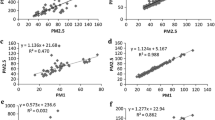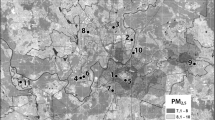Abstract
Introduction
It has been noticed many times that schools are buildings with high levels of particulate matter concentrations. Several authors documented that concentrations of particulate matter in indoor school microenvironments exceed limits recommended by WHO namely when school buildings are situated near major roads with high traffic densities. In addition, exercise under conditions of high particulate concentrations may increase the adverse health effects, as the total particle deposition increases in proportion to minute ventilation, and the deposition fraction nearly doubles from rest to intense exercise.
Site and methods
Mass concentrations of size-segregated aerosol were measured simultaneously in an elementary school gym and an adjacent outdoor site in the central part of Prague by two pairs of collocated aerosol monitors—a fast responding photometer DusTrak and a five stage cascade impactor. To encompass seasonal and annual differences, 89 days of measurements were performed during ten campaigns between 2005 and 2009.
Results and discussion
The average (all campaigns) outdoor concentration of PM2.5 (28.3 μg m−3) measured by the cascade impactors was higher than the indoor value (22.3 μg m−3) and the corresponding average from the nearest fixed site monitor (23.6 μg m−3). Indoor and outdoor PM2.5 concentrations exceeded the WHO recommended 24-h limit in 42% and 49% of the days measured, respectively. The correlation coefficient (r) between corresponding outdoor and indoor aerosol sizes increased with decreasing aerodynamic diameter of the collected particles (r = 0.32–0.87), suggesting a higher infiltration rate of fine and quasi-ultrafine particles. Principal component analysis revealed five factors explaining more than 82% of the data variability. The first two factors reflected a close association between outdoor and indoor fine and quasi-ultrafine particles confirming the hypothesis of high infiltration rate of particles from outdoors. The third factor indicated that human activity is the main source of indoor emission of coarse particles. The fourth factor involved only outdoor variables showing the resuspension of coarse ambient aerosol on dry and warm days without its seeming effect on the indoor coarse PM levels. Having in mind that high concentrations of both fine and coarse aerosol were frequently observed in the studied space, our results suggest that indoor exercise in polluted urbanized areas may increase the overall exposure and thus represent a potential health risk to young individuals during physical education at schools.




Similar content being viewed by others
References
Avigo D, Godoi AFL, Janissek PR, Makarowska J, Krata A, Vermaak SP, Alfoldy B, Van Grieken R, Godoi RHM (2008) Particulate matter analysis at elementary schools in Curitiba, Brazil. Anal Bioanal Chem 391:1459–1468
Blondeau P, Iordache V, Poupard O, Genin D, Allard F (2005) Relationship between outdoor and indoor air quality in eight French schools. Indoor Air 15:2–12
Braniš M (2009) Air quality of Prague: traffic as a main pollution source. Environ Monit Assess 156(1–4):377–390
Braniš M, Řezáčová P, Domasová M (2005) The effect of outdoor air and indoor human activity on mass concentration of PM10, PM2.5 and PM1 in a classroom. Environ Res 99(2):143–149
Braniš M, Šafránek J, Hytychová A (2009) Exposure of children to airborne particulate matter of different size fractions during indoor physical education at school. Build Environ 44(6):1246–1252
Brunekreef B, Forsberg B (2005) Epidemiological evidence of effects of coarse airborne particles on health. Eur Respir J 26:309–318
Brunekreef B, Janssen NAH, de Hartog J, Harssema H, Knape M, van Vliet P (1997) Air pollution from traffic and lung function in children living near motorways. Epidemiology 8:298–303
Chan TW, Mozurkewich M (2007a) Simplified representation of atmospheric aerosol size distributions using absolute principal component analysis. Atmos Chem Phys 7:875–886
Chan TW, Mozurkewich M (2007b) Application of absolute principal component analysis to size distribution data: identification of particle origins. Atmos Chem Phys 7:887–897
Costabile F, Birmili W, Klose S, Tuch T, Wehner B, Wiedensohler A, Franck U, Konig K, Sonntag A (2009) Spatio-temporal variability and principal components of the particle number size distribution in an urban atmosphere. Atmos Chem Phys 9:3163–3195
Daisey JM, Angell WJ, Apte MG (2003) Indoor air quality, ventilation and health symptoms in schools: an analysis of existing information. Indoor Air 13:53–64
Diapouli E, Chaloulakou A, Spyrellis N (2007) Indoor and outdoor particulate matter concentrations at schools in the Athens area. Indoor Built Environ 16:55–61
Ekmekcioglu D, Keskin SS (2007) Characterization of indoor air particulate matter in selected elementary schools in Istanbul, Turkey. Indoor Built Environ 16(2):169–176
Ferro AR, Kopperud RJ, Hildemann LM (2004) Source strengths for indoor human activities that resuspend particulate matter. Environ Sci Technol 38(6):1759–1764
Fox A, Harley W, Feigley C, Salzberg D, Toole C, Sebastian A, Larsson L (2005) Large particles are responsible for elevated bacterial marker levels in school air upon occupation. J Environ Monit 7:450–456
Fromme H, Twardella D, Dietrich S, Heitmann D, Schierl R, Liebl B, Ruden H (2007) Particulate matter in the indoor air of classrooms—exploratory results from Munich and surrounding area. Atmos Environ 41:854–866
Gauderman WJ, Avol E, Gilliland F, Vora H, Thomas D, Berhane K, McConnell R, Kuenzli N, Lurmann F, Rappaport E, Margolis H, Bates D, Peters J (2004) The effect of air pollution on lung development from 10 to 18 years of age. N Engl J Med 351(11):1057–1067
Geller MD, Chang MH, Sioutas C, Ostro BD, Lipsett MJ (2002) Indoor/outdoor relationship and chemical composition of fine and coarse particles in the southern California deserts. Atmos Environ 36(6):1099–1110
Goyal RL, Khare M (2009) Indoor-outdoor concentrations of RSPM in classroom of naturally ventilated school building near urban traffic roadway. Atmos Environ 43:6026–6038
Green RS, Smorodinsky S, Kim JJ, McLaughlin R, Ostro B (2004) Proximity of California public schools to busy roads. Environ Health Perspect 112:61–66
Heudorf U, Neitzert V, Spark J (2009) Particulate matter and carbon dioxide in classrooms—the impact of cleaning and ventilation. Int J Hyg Environ Health 212:45–55
Janssen NAH, Hoek G, Harssema H, Brunekreef B (1997) Childhood exposure to PM10: relation between personal, classroom, and outdoor concentrations. Occup Environ Med 54(12):888–894
Janssen NAH, van Vliet PHN, Aarts F, Harssema H, Brunekreef B (2001) Assessment of exposure to traffic related air pollution of children attending schools near motorways. Atmos Environ 35:3875–3884
Jones NC, Thornton CA, Mark D, Harrison RM (2000) Indoor/outdoor relationships of particulate matter in domestic homes with roadside, urban and rural locations. Atmos Environ 34(16):2603–2612
Kingham S, Durand M, Harrison J, Cavanagh J, Epton M (2008) Temporal variations in particulate exposure to wood smoke in a residential school environment. Atmos Environ 42:4619–4631
Korenstein S, Piazza B (2002) An exposure assemment of PM10 from a major highway interchange: are children in nearby schools at risk? J Environ Health 65(2):9–17
Künzli N (2002) The public health relevance of air pollution abatement. Eur Respir J 20:198–209
Kuruvilla J, Karnae S, Crist K, Myoungwoo K, Kulkarmi A (2007) Analysis of trace elements and ions in ambient fine particulate matter at three elementary schools in Ohio. J Air Waste Manage Assoc 57(4):394–406
Lee SC, Chang M (2000) Indoor and outdoor air quality investigation at school in Hong Kong. Chemosphere 41:109–113
Long C-M, Suh HH, Catalano PJ, Koutrakis P (2001) Using time- and size-resolved particulate data to quantify indoor penetration and deposition behavior. Environ Sci Technol 35(10):2089–2099
Misra Ch, Singh M, Shen S, Sioutas C, Hall P (2002) Development and evaluation of a personal cascade impactor sampler. J Aerosol Sci 33:1027–1047
Mittleman MA (2007) Air pollution, exercise, and cardiovascular risk. NEJM 357(11):1147–1149
Parker JL, Larson RR, Eskelson E, Wood EM, Veranth JM (2008) Particle size distribution and composition in a mechanically ventilated school building during air pollution episodes. Indoor Air 18:386–393
Poupard O, Blondeau P, Iordache V, Allard F (2005) Statistical analysis of parametres influencing the relationship between outdoor and indoor air quality in schools. Atmos Environ 39:2071–2080
Rundell KW, Hoffman JR, Caviston R, Bulbulian R, Hollenbach AM (2007) Inhalation of ultrafine and fine particulate matter disrupts systemic vascular function. Inhal Toxicol 19:133–140
Smedje G, Norback D (2001) Incidence of asthma diagnosis and self-reported allergy in relation to the school environment—a four-year follow-up study in schoolchildren. Int J Tuberc Lung Dis 5(11):1059–1066
Stranger M, Potgieter-Vermaak SS, Van Grieken R (2008) Characterization of indoor air quality in primary schools in Antwerp, Belgium. Indoor Air 18:454–463
Thatcher TL, Layton DW (1995) Deposition, resuspension and penetration of particles within a residence. Atmos Environ 29(13):1487–1492
Vaclavik-Bräuner E, Forchhammer L, Møller P, Simonsen J, Glasius M, Wåhlin P, Raaschou-Nielsen O, Loft S (2007) Exposure to ultrafine particles from ambient air and oxidative stress-induced cDNA damage. Environ Health Perspect 115(8):1171–1182
Van Dijken F, Bronswilj JEHM, Sundell J (2006) Indoor environment and pupils’ health in primary schools. Build Res Inf 34(5):437–446
Van Roosbroeck S, Jacobs J, Janssen NAH, Oldenvening M, Hoek G, Brunekreef B (2007) Long-term personal exposure to PM2.5 soot and NOx in children attending schools near busy roads a validation study. Atmos Environ 41:3381–3394
Villarreal-Calderón A, Acuña H, Villarreal-Calderón J, Garduño M, Henríquez-Roldán CF, Calderón-Garcidueñas L, Valencia-Salazar G (2002) Assessment of physical education time and after-school outdoor time in elementary and middle school students in south Mexico City: the dilemma between physical fitness and the adverse health effects of outdoor pollutant exposure. Arch Environ Health 57(5):450–460
Wehner B, Wiedensohler A (2003) Long term measurements of submicrometer urban aerosols: statistical analysis for correlations with meteorological conditions and trace gases. Atmos Chem Phys 3:867–879
Wu Y-C, Batterman SA (2006) Proximity of schools in Detroit, Michigan to automobile and truck traffic. J Expo Anal Environ Epidemiol 16:457–470
Acknowledgement
This work was supported by the Czech Ministry of Education Youth and Sport research grant INAIR No. NPV II 2B08077.
Author information
Authors and Affiliations
Corresponding author
Additional information
Responsible editor: Euripides Stephanou
Rights and permissions
About this article
Cite this article
Braniš, M., Šafránek, J. & Hytychová, A. Indoor and outdoor sources of size-resolved mass concentration of particulate matter in a school gym—implications for exposure of exercising children. Environ Sci Pollut Res 18, 598–609 (2011). https://doi.org/10.1007/s11356-010-0405-0
Received:
Accepted:
Published:
Issue Date:
DOI: https://doi.org/10.1007/s11356-010-0405-0




